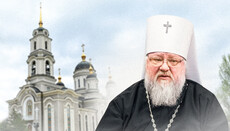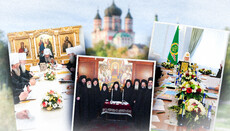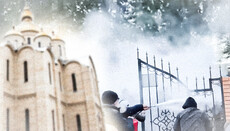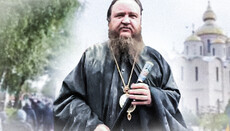The “victorious” world of the OCU: seized churches, no parishioners
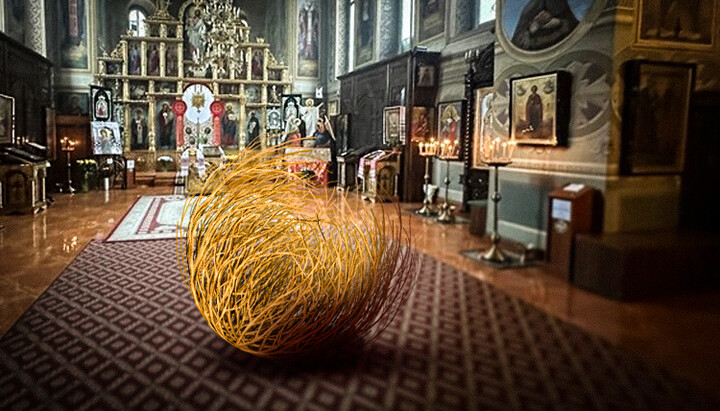
In Ukraine, there are more and more seized churches in which there are no priests and believers. Where will all this lead?
Recently, almost every day we hear about the seizure of one or another temple of the Ukrainian Orthodox Church by supporters of the OCU. Dumenko and his fellow "bishops" happily report on the acceptance of new religious communities into their jurisdiction.
Let's take one of the most striking recent examples – the "transition" in Dovzhok village on the outskirts of Kamyanets-Podilskyi. Here, the “bishop” Pavlo Yurysty “received” in the OCU under the guise of the community of the UOC of the Nativity of the Mother of God the officials of the local city council: Alla Chepelyuk, press secretary of the Kamyanets-Podilskyi City Council, and adviser to the mayor Yaroslav Klizub. The latter, by the way, by religion is a Greek Catholic.
On August 20, officials gathered the crowd that was absolutely alien to the religious community near the temple. Meanwhile, the actual community prayed inside the church, while outside, activists, some in clothes with satanic symbols, voted for their conversion to the OCU. It got to the point that the organizers stopped cars on the track and collected signatures from drivers and passengers. This is how the "transition" took place. Will anyone go there if the temple can be physically seized from the real community?
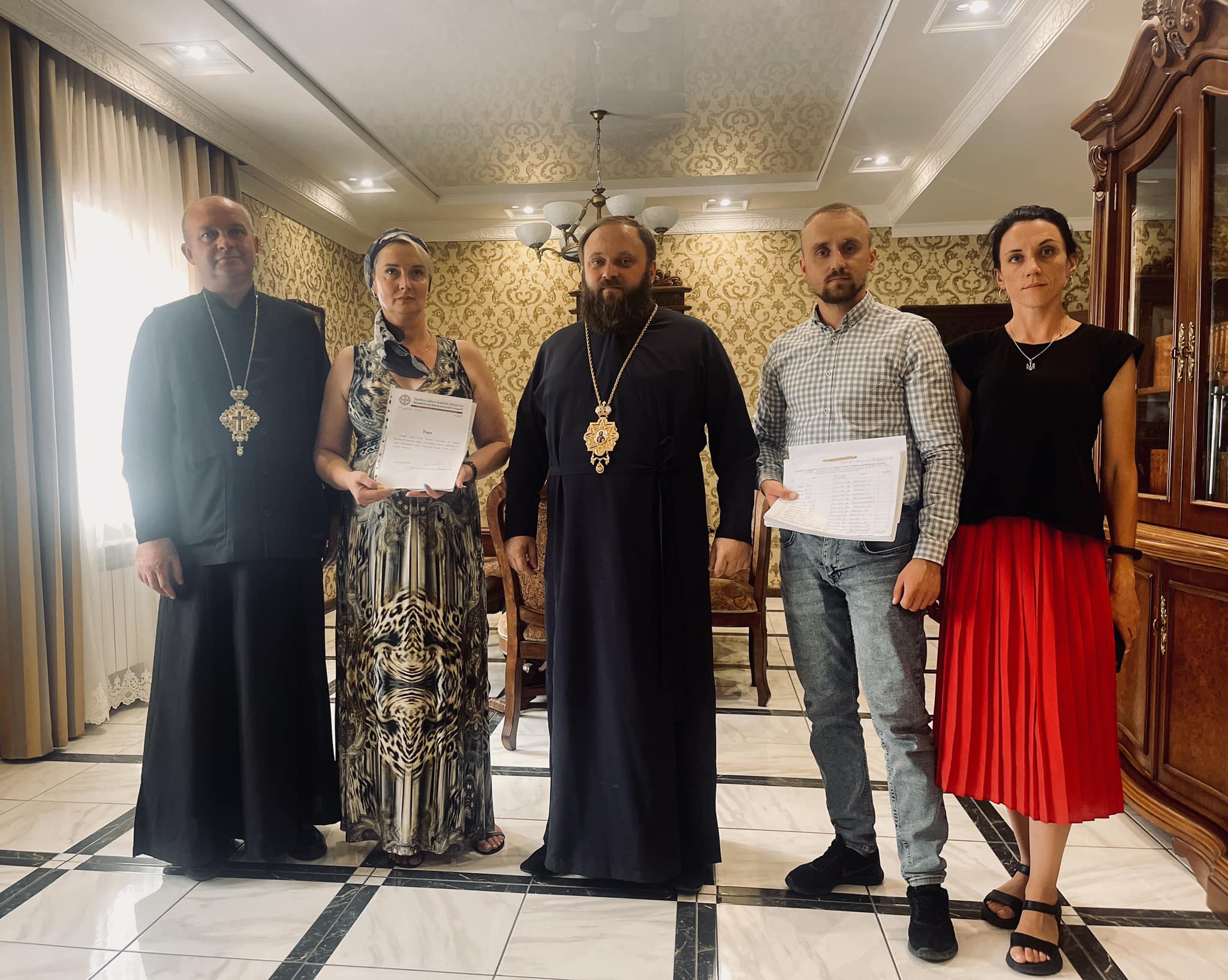
And this is a very revealing case – temples are taken away, people are expelled. But what's next? Where to get new parishioners and a new priest? For a resonant seizure like in Kamyanets, they may find a “priest”; after all, this is a rather large city.
However, in the villages the situation is quite different. Though Dumenkovites hush up this situation, it still makes itself felt – a severe shortage of the personnel among the clergy and the almost complete absence of parishioners. Why is this happening and will the OCU be able to solve this problem?
The “clergy” crisis faced by the OCU
The OCU does not openly talk about the crisis of “spiritual vocation”. The reason is clear. The "largest church" in Ukraine, which is "supported by the majority of the people," cannot admit that it has a catastrophic shortage of both parishioners and "clergymen" now. However, indirect data suggests that there is a crisis and a very serious one.
For example, during his speech at the recent OCU “synod” of the, Dumenko published figures that indicate a clear discrepancy between the number of parishes of the OCU and the number of “priests”. According to Dumenko, the OCU currently has 8,500 communities and 5,500 clergy. Judging by the questionable survey data that the Dumenko-led structure eagerly publishes, claiming support from almost 70-80% of Ukrainians, the figures for churches and "clergymen" are likely inflated. But even if we accept Dumenko's numbers, it means that at least 3,000 communities do not have a pastor. And if we also consider that the clergy includes not only priests but also deacons, the situation becomes even more dismal.
Furthermore, the gap between the number of parishes and "clergymen" in the OCU is constantly growing, as the takeovers continue, and the parish priests of the UOC do not want to switch to Dumenko's side. For example, a clergyman from the OCU in the Khmelnytskyi region, Zakhar Zaliznyi, stated that "since 2014, 250 parishes in Khmelnytskyi region have switched to the OCU, but only 20 priests from the UOC." The difference, as we can see, is more than tenfold.
The words of Zaliznyi are corroborated by "hegumen" Akhila from Cherkasy, who mentioned that UOC priests do not want to join the OCU and prefer to serve at home.
In other words, the problem of a shortage of personnel within the OCU exists and is only increasing over time. Dumenko and his associates understand this and are trying to find some way out.
We employ everyone without bad habits
In particular, in the city of Cherkasy, the "bishop" of the OCU, Ivan Yaremenko, organized distance learning courses for those who wish to become "rectors" in one of the seized UOC temples. At the moment, supporters of Dumenko have managed to take away 60 temples in the Cherkasy region from the canonical Church, which still has 200 more under its control. Even in this situation, Yaremenko understands that "it's important for us to have a source of devout candidates (for rectors)." The situation is so dire that the Cherkasy "hierarch" of the OCU is willing to "ordain" anyone who has at least no harmful habits.
Similar appeals from other OCU "bishops" have been made before. For instance, as early as 2019, the "Metropolitan" of Chernivtsi and Bukovyna, Daniel, stated that his structure was experiencing a "temporary shortage of clergy." He literally begged his parishioners to seek out men in their villages who could "take on the burden of priesthood." Daniel promised that they would be taught the required skills.
Daniel's colleague, Paisiy Kukharchuk, the "bishop" of Zhytomyr and Ovruch, went a step further and organized training courses for the "clergy" in his eparchy. Advertisements for these courses appeared in the Zhytomyr region even on street poles, but the duration and content of these courses remained a secret.
We can only assume that, in reality, these courses did not exist, and there was no actual training.
The second point is that these announcements indirectly acknowledge that there are no priests in the seized temples. There are buildings, but no one to serve there. But what is most worrisome for the OCU is the obvious fact that there is no one to pray in these temples either.
People don't go to an empty source
Indeed, very often the churches seized by the Dumenko followers stand empty. Let's take just a few recent examples. On June 11, 2023, on the Sunday of All Saints, representatives of the Khmelnytskyi Eparchy of the UOC visited 5 churches in the Derazhnya deanery that had been illegally transferred to the OCU. These were the Intercession Church in the village of Kopachivka, the Nativity of the Virgin Mary Church in the village of Slobidka-Kalnianska, the Assumption Church in the village of Kalna, the Archangel Michael Church in the village of Radovtsi, and the Archangel Michael Church in the village of Haluzyntsi.
The camera operator visited all these churches from 9 to 10 in the morning, when the usual church service takes place. All of them were found to be closed.
A month earlier, on May 7, 2023, during the Sunday "service" of the OCU in the seized UOC Church of the Kazan Icon of the Mother of God in Khmelnytskyi, there was a church service, but... it had absolutely (!) no parishioners.
But when Dumenko can't gather anyone in the heart of Ukrainian Orthodoxy – the Kyiv-Pechersk Lavra, it says a lot. After all, both Dumenko, Zoria, and many others claim that the Ukrainian people are eager to pray in the Lavra with the OCU.
True though, Epifaniy has already established a system where people are brought by buses from other cities to the monastery for major holidays. However, on regular Sundays, no more than 10-15 people come to Lavra led by the new “abbot” from the OCU, Avraamy Lotysh.
And the photo of the empty Refectory Church during the All-Night Vigil of the Transfiguration (!) brilliantly proved this. In previous years, hundreds of parishioners prayed here during the same UOC service.

This disgraceful photo, which caused such a wide resonance in the media, prompted the spokesperson of the Dumenko-led structure, E. Zoria, to attempt an "anti-crisis" move by stating that they are not seeking mass attendance in their churches. A good attempt, but the mass influx of people from other cities to the Lavra for the Assumption feast vividly contradicted his words.
The problem of the lack of parishioners in the OCU is so evident that it is acknowledged even within this structure. For instance, "priest" of the OCU, Nestor Nazarov, mentioned that in the Chernihiv region, there is a real "race to transfer as many communities (from the UOC) as possible." However, he states that "in many parishes, no one serves, services have not been held for 10 months." Nazarov asks his leadership, "We have many seminaries, where do the graduates go? Why are the parishes empty? Is a personnel problem so big? How are we going to solve it?" He doesn't have an answer, but he is compelled to acknowledge that the same personnel problem exists "in western Ukraine too, where churches stand empty, and there is no one to serve."
"What are the prospects for the OCU if there are no new personnel?!" Nazarov reasonably and justly questions.
Where is the Church?
Nazarov asked his question back in late 2022, but since then, the situation has only worsened – more UOC churches have been seized, and consequently, more churches stand empty.
Partially, this question was answered by pilgrims from Kamyanets-Podilskyi to Pochaiv, who, despite bans, insults, summons, threats of physical violence, went on a cross procession and reached the Pochaiv Lavra.
Will these people go to the churches taken from the UOC, now under Dumenko's control? Even if they find "rectors" there "without harmful habits"? The question is rhetorical.
Dumenko and his structure have discredited themselves so much, so firmly associated not with the cross and the Gospel but with a crowbar and an angle grinder that our believers are ready to go into the woods, pray in basements, or private homes, but never in the OCU. By the way, about the woods – this is not an exaggeration at all. For example, the expelled community in Trebukhiv now prays exactly like that. And the fact that the parishioners whose churches were taken away continue to hold services in "catacombs" is well known even in the OCU. The same Cherkasy cleric, Akhila Bahlay, says that UOC believers are seeking "some kind of sanctity" in their homes.
No matter how hard the authorities and Dumenko's supporters try to destroy the Church, they can't do anything other than seize buildings. Yes, there is a certain part of the "parishioners" who don't care where to bless the Easter cakes or the sausage for Christmas. But Christianity is not about that. The Church consists of simple believers and clergy, the head of which is the Lord Himself. And by taking away our buildings, the Dumenko followers fail to grasp one simple truth: the Church is not in the logs and stones but in the ribs.
This popular wisdom states that the Church, first and foremost, is not buildings or stones but people, united in the Body of Christ by one faith, sacraments, and hierarchy. In other words, no matter how many buildings they take away from us, the Church will not disappear, and communities of believers will not vanish. And the same thousands of pilgrims who, despite everything, "broke through" to the Pochaiv Lavra, bears the best witness to that.
The tactic of physical takeovers is a practice that leads only to a "Soviet" situation, where churches will stand closed, and believers, hiding and concealing, will come to "home" churches or travel dozens of kilometers to places where churches were not seized. And if in the OCU they think it will be different, we will disappoint them – it won't. Because people ready to walk 200 kilometers to the Pochaiv Lavra will never betray their Church. It is more valuable to them than life.

